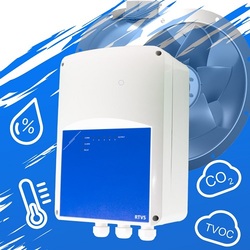EU declaration conformity
Fan speed controller | Modbus RTU controlled | 2,5 A
Product description
This transformer fan speed controller regulates the fan speed manually or on demand. It controls single-phase motors with 230 V AC supply voltage.
The maximum (eventually combined) motor current is 2.5 A.
The fan speed is controlled by a step change in motor voltage. The autotransformer technology allows for a perfectly sinusoidal motor voltage. This guarantees quiet motor operation. A special impregnation coating reduces electrical noise from the autotransformer.
RTVS1 operates via Modbus protocol. For automatic control, it is necessary to connect Sentera HVAC sensors for temperature, relative humidity, CO2 and air quality (TVOC). Manual control is accomplished using a potentiometer (SPV series). In addition, a BMS system can set the fan speed via Modbus communication.
The plastic IP54 enclosure is designed for surface mounting.
Documents
Additional specifications and description
Autotransformer technology is used to reduce the motor voltage and the fan speed in 5 steps. This speed controller is therefore only suitable for AC voltage controllable motors. What makes this series of transformer fan speed controllers special is that in place of the standard knob that is built-into the unit enclosure, it features Modbus RTU control signal that is required to activate one of the available speed levels.
It also features the so-called manual and automatic control mode.
In manual mode, a BMS system or a Modbus RTU master device can be used to select the desired fan speed via Holding register 12.

In automatic mode, a Sentera HVAC sensor or SPV series of potentiometers is connected to the RTVS1 controller. The type of the connected device must be specified via Modbus register 18. Fan speed is controlled via the connected device. So, in automatic mode, fan speed can be controlled based on temperature, relative humidity, CO2, air quality (TVOC), CO, NO2 measured by the connected sensor or the SPV potentiometer. If you go for the digital potentiometer, you can control the RTVS remotely using the potentiometer, while the transformer can remain in the technical room. In combination with DADCM, RTVS1 series can be controlled via a 0-10 Volt analogue input signal.
What are the additional features?
In automatic mode, fan speed can increase or decrease as the control signal increases. These operating modes are called Auto forward and Auto reverse modes. One of these operating modes can be selected via Holding register 11. Auto forward mode means that the fan speed will increase when the measured value increases. In Auto reverse mode, fan speed will be reduced when the measured value increases. For example, this can be used for heating and cooling applications, i.e. fan speed based on measured temperature values.
Extra unregulated output
The functionality of the extra, unregulated output (230 VAC) can be selected via Modbus register 19. By default, it indicates alarms. It can also indicate motor operation or it can be controlled via Modbus register 15. When the unregulated output is active, it provides 230 Volt output voltage.
TK contacts
This fan speed controller can monitor thermal motor contacts (TK). Thermal contacts measure temperature inside the motor windings. If the motor is overheated, the TK monitoring function will disable the motor to prevent motor damage. If the motor is not equipped with TK contacts, the TK monitoring function can be disabled via Modbus Holding register 14 (this is the default setting). So, if your motor has thermal contacts and they are connected to the RTVS1 controller, do not forget to activate this function via Holding register 14.
Auto restart after power failure
In case of a power failure, this controller will automatically reset itself. When the power is restored, the motor will restart automatically.
The housing of this fan speed controller is designed and manufactured in-house using high-quality r-ABS VO (UL94) plastic, which possesses several desirable properties for this application. The flame-extinguishing nature of r-ABS VO plastic ensures an added level of safety, which is crucial in industrial environments, where fire hazards may be present. Its toughness and impact resistance make it well-suited for protecting the internal components of the controller from accidental damage or rough handling.
The IP54 protection rating provided by the enclosure offers a good level of defense against both dust and water ingress. This protection is particularly important in industrial settings where airborne particles and moisture can pose risks to electronic devices. With this level of protection, the fan speed controller can operate reliably even in environments where dust and water exposure may occur. Make sure the fan speed controller can cool sufficiently. Preferably install it in a cool place, ideally not in direct sunlight.







.webp)
.webp)
.webp)
.webp)
.webp)
.webp)
Remarks, reviews & ratings